It’s been a busy few days on The Cut, which is what the cool kids call the canal system. The Cut. I guess because it was cut into the earth - a man-made thing. Although actually, much of the last few days the canal has run alongside the River Cherwell, and it’s felt like a much more natural waterway. Certainly the banks and the towpath are much more natural. To a fault at times, but I’m getting ahead of myself. When last we left our hero she was moored at Napton-on-the-Hill having stocked up on water buffalo sausages, stilton, and other staples, awaiting the arrival of the third crew of the trip.
Day 11: Napton to Fenny Compton
Joined by Mark and Kathy, who would stay overnight and help me through the first narrow locks of the trip. The Grand Union Canal has broad locks which fit two narrowboats side by side. The Oxford Canal is all narrow locks all the time, which is really fun. Narrow locks fill faster and empty faster. The gates are easier to operate. And if the locks isn’t too deep you can even shortcut across the boat to get from one side of the lock to the other. Even without crew it’s much easier to manage, though they do feel tight coming in and out.
That photo also shows how overgrown and natural the banks of the Oxford Canal can be. This means it can get quite shallow along the sides, which is tricky if you have to nudge over for a boat passing in the other direction. There were a few times when we slid up along a bit of high ground and the boat starting tilting a bit, which is a very disquieting feeling. Sometimes we even had to reverse back out to find the deeper water again. It also means you can’t just pull over anywhere to moor. The vegetation can be really dense.
Mark and Kathy were great sports - they drove out to the middle of nowhere to meet me, worked all the locks, did some time at the tiller, and even brought wine! They also have the distinction of being the first pair to overnight on the boat, displacing me onto the guest bed, which I’m happy to report was pretty comfy. We had a leisurely Day 11, completing 9 miles and 9 locks at 2.6 lmph and pulled into a mooring at Fenny Compton in time for a lazy sundowner on the boat and then a very credible dinner of pie and beer at pub # I’ve-Lost-Count, the Wharf Inn.
Day 12: Fenny Compton to Banbury
The crew had to depart at midday, but we still had a nice morning of cruising, and ran into the first of what turned out to be another job lot of bridges, these ones with a twist:
Mark and Kathy disembarked at Cropredy, where they got a taxi back to where they’d started, a 20 minute drive away. I had a quick bite of lunch and carried on, because I was starting to itch for the next big goal: Oxford.
Day 13: Banbury to Enslow
On my own again, I got up early and decided to keep going as long as possible to make sure I could get to Oxford by Friday. I was under weigh by 8:30am and things went quite smoothly... for a while. I mentioned the Oxford Canal is narrower and more wild than the Grand Union. This means it also meanders a lot more, creating blind bends aplenty. This sometimes requires quick manoeuvring if another boat appears coming the other way just as you’re entering a turn. The other feature of the Oxford is that periodically you’ll come to a man-made narrow section that looks a bit like the footing for one of those lift bridges, just without the bridge. I suspect they’re former brides, but whatever they are, they create a very skinny little navigational challenge. Not quite so narrow as a lock, but still requiring one to slow down and take care.
Not long after I’d made my morning coffee on Day 13, I encountered all of those navigational puzzles at the same time - a blind bend, through a narrows, with the sudden appearance of an oncoming boat. There was a bit of cursing and reversing, and I bumped the brick of the narrows with slightly alarming force. The boat survived, but sadly I lost ANOTHER fender and my travel coffee cup leapt to its death. Though it didn’t leave the boat, both the lid and the cup itself sustained irreparable damage. RIP coffee cup.
The locks also got quite deep - which makes locking on your own a bit trickier. When the boat is deep down in a lock the only way to get up or down in order to operate the paddles or open and close gates is to climb a ladder that’s set in side of the lock wall. Since they spend much of their time underwater these ladders get pretty slippery, so you have to pay close attention.
There are a few very low bridges on the Oxford, one in particular proved detrimental to my chimney. I was concentrating on clearing the port side, where I’ve got a better view, and miscalculated a bit, causing the boat to bump the edge on the starboard side. And of course the curve of the bridge was too shallow for my port side chimney, which was slightly crunched by the bridge. They’re designed to come off, but mine was kind of stuck on with creosote/rust/gunk so the bridge did me the favour of dislodging it with a pretty significant amount of force. (The A in F=MA may not have been great, but the M of even a small narrowboat is very high indeed.)
More drama later in the day when I got wedged coming out of a lock. Because they’re so narrow you’re supposed to pull out your fenders - the squishy bumpers that hang off the sides of the boat - to avoid getting stuck. I forgot to do that, and needed help to get the offending articles yanked out of the way so I could keep going. Happily, the boat coming into the lock was full of visiting Canadians, so we had a nice chat while the rescue was performed.
I pushed on hard on Day 13, and since the days are still very long it was already 8:15 as I was passing out of the last lock of the day. It was another deep-dish one - 8’4” - but everything was going smoothly until I was half-way out the lock. At that point the boat just stopped, half in, half out. It was as if the fenders were stuck again, except that the fenders were up and I could see daylight all the way along both sides. I must have been grounded out on the lower edge of the lock.
To add to the difficulty, the boat was well past the ladder so I couldn't easily climb out of the lock. I just managed to jump from the roof of the boat up onto the lock edge, and had to go get help. If that lock had been six inches deeper I might still be there! Luckily, a woman from a nearby moored boat came and helped. In general boaters are super helpful to other boaters. I guess they understand too well what it's like to be in a bind on a boat. I jumped back down to the boat and my rescuer opened the upper paddles to get some more water into the lock and try to float the boat up over the obstruction. That didn’t quite work but when she did that while also hauling on the bow line I was dislodged and made it out. Enough already, Day 13!
When I finally found a mooring a little ways down I’d chalked up a total of 17 miles and 11 locks over 12 hours. It was a bit epic, which was confirmed by my new next-boat-neighbour, who was very impressed with my progress that day. He said it normally takes him three days to get from Banbury, so I was feeling kinda heroic. Sure there were some bumps along the way, but I figure any day where you're still floating at the end is a win.
Day 14: Enslow to Oxford
Part of the reason I pushed so hard on Day 13 was to get to Oxford as early as possible in the day. It’s a popular, busy place, especially in the summer so the earlier I arrived the more likely I’d find a nice mooring.
Much less drama on Day 14, though there was an incident with the ever-vexing silted up banks of the Oxford Canal. I tried to pull over for my morning coffee but the bow got stuck along the bank and I was having trouble manoeuvring my way out. I’d deliberately chosen a spot where another boat was moored, as I thought that would indicate a welcoming area. I gunned the engine back and forth and poked at the bank with the boathook, and soon the man from the moored boat came over and gave me some steering tips that got me dislodged. Then his wife walked along the towpath to help me moor further up. I think they thought I was a complete newbie, because she was full of advice for the final push to Oxford. “Make yourself a sandwich, and get your water ready so you don't have to stop.” Then as I was boiling the kettle she came over with a bottle of water, a banana and a nectarine to tide me over. Sweet. I was a bit insulted that I came off as that useless, but the banana went very nicely with my coffee and flapjack.
And then it was a quick couple of hours, a couple locks, a couple of lift bridges, and I was in Oxford!
I’m planning to stay a few days here, see the sights, and have a rest before the last leg of the trip. More people will be making guest appearances in this last week and, excitingly, when I leave Oxford it will be on the Thames!
Day 11: Napton to Fenny Compton
Joined by Mark and Kathy, who would stay overnight and help me through the first narrow locks of the trip. The Grand Union Canal has broad locks which fit two narrowboats side by side. The Oxford Canal is all narrow locks all the time, which is really fun. Narrow locks fill faster and empty faster. The gates are easier to operate. And if the locks isn’t too deep you can even shortcut across the boat to get from one side of the lock to the other. Even without crew it’s much easier to manage, though they do feel tight coming in and out.
There’s less than six inches of clearance on each side, meaning you need to be very precise in steering. However, the boat doesn’t bounce around nearly as much when going up as it does with the broad locks. Even with a side rope secured to a bollard, my little boat bobbed around like a bath toy when those big locks filled.
Plus narrow locks have just one gate, or sometimes two teeny weeny gates. They’re so cute!
The Oxford Canal also has a very distinctive style of bridge. I’m pretty sure they must have got these bridges on sale because they just kept coming. They look very heavy but much of that depth is actually the handrail; the arch itself is quite shallow. A lot of them were grass all the way over - linking two fields so livestock could pass over.
Mark and Kathy were great sports - they drove out to the middle of nowhere to meet me, worked all the locks, did some time at the tiller, and even brought wine! They also have the distinction of being the first pair to overnight on the boat, displacing me onto the guest bed, which I’m happy to report was pretty comfy. We had a leisurely Day 11, completing 9 miles and 9 locks at 2.6 lmph and pulled into a mooring at Fenny Compton in time for a lazy sundowner on the boat and then a very credible dinner of pie and beer at pub # I’ve-Lost-Count, the Wharf Inn.
The pie really was nice. Beef & Stilton (you could really taste the stilton!). And they offered extra gravy and didn’t complain when we were the last ones to leave.
The crew had to depart at midday, but we still had a nice morning of cruising, and ran into the first of what turned out to be another job lot of bridges, these ones with a twist:
Lift bridges! Most of them were left open, so there was no need to stop. Later I’d run into a few that were locked down, which meant mooring, getting out and unlocking the bridge, lifting it up (they’re counterweighted), going back to the boat and driving through, mooring on the other side, walking back and pulling the bridge back down (there’s a chain that dangles down for you to pull on), locking it, walking back to the boat and carrying on. Not as time consuming as a lock, but still a barrier. And when I say “run into” I don’t literally mean I ran into the bridge. Though later...
But first, a shameless selfie!
And a gripe - the bollards at the narrow locks on the Oxford Canal are rubbish! You call that a bollard?? What, exactly, is supposed to stop the rope from slipping off the top? Nothing, that’s what. Oxford Canal, you really need to up your game on the bollards for lock mooring. Eventually I got a technique figured out, but I shouldn’t have had to.
I made it to Banbury in good time on Day 12 and found a shady and beautiful mooring that was green and quiet but also a 15 minute walk to a Waitrose.
Where I made a few purchases and had a quiet night in preparation for a big day.
On my own again, I got up early and decided to keep going as long as possible to make sure I could get to Oxford by Friday. I was under weigh by 8:30am and things went quite smoothly... for a while. I mentioned the Oxford Canal is narrower and more wild than the Grand Union. This means it also meanders a lot more, creating blind bends aplenty. This sometimes requires quick manoeuvring if another boat appears coming the other way just as you’re entering a turn. The other feature of the Oxford is that periodically you’ll come to a man-made narrow section that looks a bit like the footing for one of those lift bridges, just without the bridge. I suspect they’re former brides, but whatever they are, they create a very skinny little navigational challenge. Not quite so narrow as a lock, but still requiring one to slow down and take care.
Not long after I’d made my morning coffee on Day 13, I encountered all of those navigational puzzles at the same time - a blind bend, through a narrows, with the sudden appearance of an oncoming boat. There was a bit of cursing and reversing, and I bumped the brick of the narrows with slightly alarming force. The boat survived, but sadly I lost ANOTHER fender and my travel coffee cup leapt to its death. Though it didn’t leave the boat, both the lid and the cup itself sustained irreparable damage. RIP coffee cup.
The locks also got quite deep - which makes locking on your own a bit trickier. When the boat is deep down in a lock the only way to get up or down in order to operate the paddles or open and close gates is to climb a ladder that’s set in side of the lock wall. Since they spend much of their time underwater these ladders get pretty slippery, so you have to pay close attention.
Here’s a deep lock, and you can just make out the indentation for the ladder on the right. You can also see how icky the lock walls get. I’ve been slimed a few times moving around deep in a lock. I passed through the deepest lock on the Oxford on Day 13 - the 12’ Somerton Deep.
The Oxford Canal also likes to put a nice narrow, low bridge right at the lower mouth of a lock, so when you’re coming out you’re hemmed in on both sides and above. The stairs are there so that people opening and closing gates can get back on the boat as it passes out of the lock. At least that’s my theory.
The little rain hat on the chimney has a chunk out of it now, but it could have been worse.
I pushed on hard on Day 13, and since the days are still very long it was already 8:15 as I was passing out of the last lock of the day. It was another deep-dish one - 8’4” - but everything was going smoothly until I was half-way out the lock. At that point the boat just stopped, half in, half out. It was as if the fenders were stuck again, except that the fenders were up and I could see daylight all the way along both sides. I must have been grounded out on the lower edge of the lock.
Stuck!
When I finally found a mooring a little ways down I’d chalked up a total of 17 miles and 11 locks over 12 hours. It was a bit epic, which was confirmed by my new next-boat-neighbour, who was very impressed with my progress that day. He said it normally takes him three days to get from Banbury, so I was feeling kinda heroic. Sure there were some bumps along the way, but I figure any day where you're still floating at the end is a win.
Day 14: Enslow to Oxford
Part of the reason I pushed so hard on Day 13 was to get to Oxford as early as possible in the day. It’s a popular, busy place, especially in the summer so the earlier I arrived the more likely I’d find a nice mooring.
Much less drama on Day 14, though there was an incident with the ever-vexing silted up banks of the Oxford Canal. I tried to pull over for my morning coffee but the bow got stuck along the bank and I was having trouble manoeuvring my way out. I’d deliberately chosen a spot where another boat was moored, as I thought that would indicate a welcoming area. I gunned the engine back and forth and poked at the bank with the boathook, and soon the man from the moored boat came over and gave me some steering tips that got me dislodged. Then his wife walked along the towpath to help me moor further up. I think they thought I was a complete newbie, because she was full of advice for the final push to Oxford. “Make yourself a sandwich, and get your water ready so you don't have to stop.” Then as I was boiling the kettle she came over with a bottle of water, a banana and a nectarine to tide me over. Sweet. I was a bit insulted that I came off as that useless, but the banana went very nicely with my coffee and flapjack.
And then it was a quick couple of hours, a couple locks, a couple of lift bridges, and I was in Oxford!
I found a good long stretch of mooring near a park in a green and quiet area about 20 minute’s walk from the centre of town. By the time I got back from my explorations later that evening the whole area was full of boats, so it’s good I pushed to get here early.



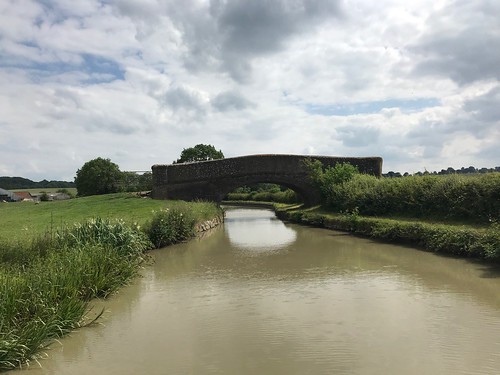

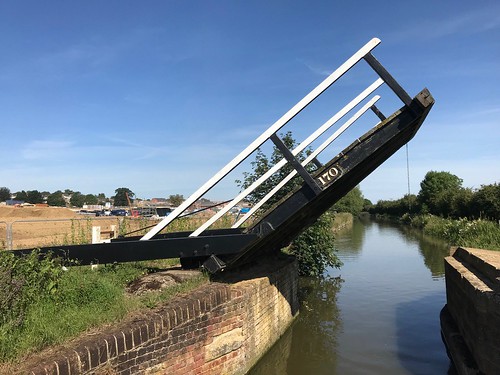


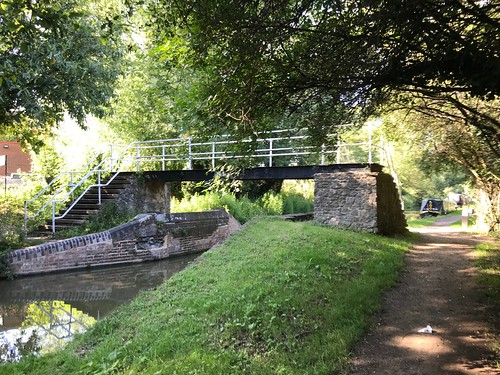

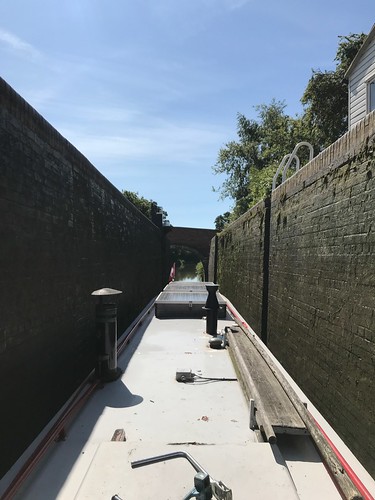



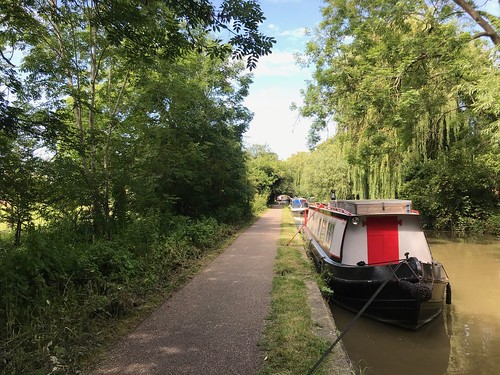


1 Comment:
What a great trip. Thanks for telling us about your adventures.
Post a Comment